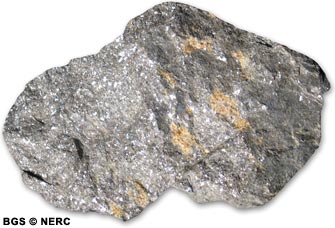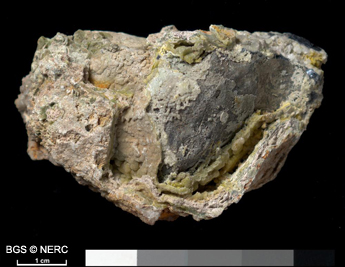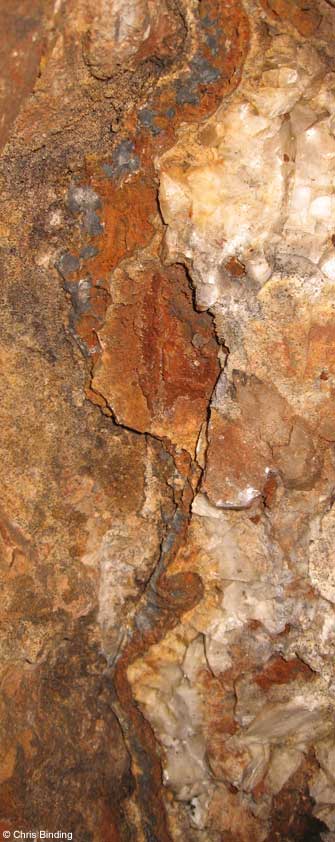
Minerals and mines
Introduction | History
of lead mining | History
of zinc mining | Lead
ore & mines
Zinc ore & mines | Iron
ore, ochre & mines | Coal mining
Lead ore and mines
Mineralisation
The lead, zinc and copper veins on Mendip were deposited by hot mineralising fluids (typically between 50 and 150° C) rising up from depth and depositing various minerals as they cooled. The source of the fluids were the deep sedimentary basins either side of the Mendips. As the Triassic and Jurassic sediments in these basins were buried, compacted and heated over time, some of the water in the rock was forced out, along with any dissolved metals and migrated into the neighbouring Carboniferous Limestone. Here the change in chemistry, temperature and pressure led to the deposition of various minerals including lead, zinc, and locally copper.
Types of lead ore

Lead ore is most commonly found as lead sulphide (PbS), galena, a heavy, shiny grey metallic ore with a conspicuous cubic cleavage, but locally pyromorphite, lead chlorophosphate (Pb5(PO4)3Cl), was worked on Green Hill, near Charterhouse and on Blagdon Hill. Around Charterhouse, the lead ore contained small amounts of silver.
The lead ore occurs in two types of deposit: as primary lead ore in thin veins known as rakes, or a secondary deposit formed by weathering of the primary lead veins.


Primary lead veins
The primary lead ore was found in thin veins cutting through the rock. In these veins, the galena occurs as either thin layers encrusting on the walls of the vein, or as thin bands, pockets or crystals within the vein. The veins were always associated with other waste minerals known as ‘gangue’, usually calcite (CaCO3) or barytes (BaSO4). Many of these veins were very thin, sometimes only a few centimetres wide, and often pinched and swelled along their length, sometimes forming complex anastomosing networks with other veins.
Secondary deposits
In many places, the lead ore occurred as large rounded ‘stones’ of galena in a soft mixture of sand and clay infilling a fissure. These deposits are secondary residual orebodies derived from now eroded primary lead veins. Being insoluble, the lead ore remained in situ as the surrounding limestone and vein calcite around them wasted away. Over time, the fragments of lead ore accumulated at ground level, keeping pace with the land surface as it was gradually lowered by erosion.
These secondary mineral deposits are often associated with ‘Neptunian dykes’, fissures in the Carboniferous Limestone infilled with younger Triassic or Jurassic sediment. Many of the spoil tips at Charterhouse and elsewhere have Triassic or Lower Jurassic material in them.
The early miners at Charterhouse and elsewhere probably found a rich bonanza of secondary lead ore deposits at or close to the surface, which pinched out at depth to thin primary veins. When the Cornish miners attempted to deepen the mines in the nineteenth century, the rich near-surface secondary deposits had been worked out and all that was left were the thin uneconomic primary veins.
Orefields
Galena was principally mined around Charterhouse, Smitham Hill, Yoxter, Chewton Warren and Green Ore, but smaller lead veins were also worked on Sandford Hill, near Tynings Farm, Burrington Ham and north of Pen Hill. Little ore was found on East Mendip.
- Home
- Overview maps
- Locality
areas
- Cheddar Gorge
- Charterhouse
- Blackdown
- Burrington Combe
- Shipham & Rowberrow
- Crook Peak & Axbridge
- Banwell to Churchill
- Priddy
- Harptree & Smitham Hill
- Draycott & Westbury-sub-Mendip
- Wookey Hole & Ebbor Gorge
- Wells
- Great Elm & Vallis Vale
- Mells & the Wadbury Valley
- The Vobster area
- The Whatley area
- Torr Works & Asham Wood
- Beacon Hill
- Stoke St Michael & Oakhill
- Holwell & Nunney
- Shepton Mallet & Maesbury
- Gurney Slade & Emborough
- The Nettlebridge valley
- Geology
- Minerals and mines
- Quarrying
- Caves and karst
- Biodiversity
- Detailed site information
- Acknowledgements
- External links
- Search
- Site map